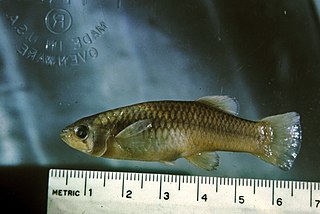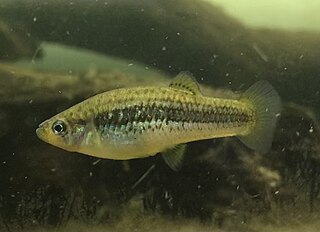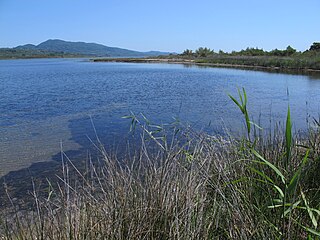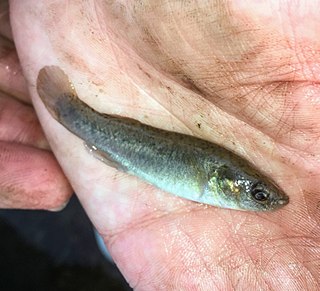The San Marcos gambusia is a likely extinct species of Gambusia from the family Poeciliidae that was found only in the San Marcos Springs of Central Texas. The fish has not been seen since 1983.
The Lake Rukwa lampeye is a species of fish in the family Poeciliidae. Its natural habitats are intermittent rivers, freshwater marshes, and intermittent freshwater marshes. It is threatened by habitat loss. This species occurs in central Africa in Lake Rukwa, Tanzania, the Malagarasi River, Wembere River system and the upper basin of the Congo River. Its specific name honours the German physician and zoologist Friedrich Fülleborn (1866-1933), who collected the type.
The meshscaled topminnow is a species of fish in the family Poeciliidae. The two population groups are a southern group of populations found in Angola, Botswana, the Republic of the Congo, Malawi, Mozambique, and Zambia and a northern population group found in Chad, the Central African Republic, the White Nile in South Sudan and Sudan and in the northern Democratic Republic of Congo. Its natural habitat is small streams and brooks, lakes, and swamps on floodplains where it lives among aquatic vegetation. This species was described by George Albert Boulenger as Haplochilus hutereaui in 1913 with the type locality being Dungu on the upper Uelé River in the Democratic Republic of Congo. Boulenger received the type from Armand Hutereau (1875–1914), who was the head of a Belgian ethnographic expedition to the Congo, so he honoured Hutereau in the specific name.
The yellowfin gambusia is a species of fish in the family Poeciliidae. It is endemic to the Rio Conchos of Chihuahua, Mexico, where it is known as guayacon de san gregorio. This species was described in 1957 by Clark Hubbs and Victor G. Springer with the type locality given as El Ojo de San Gregorio in Chihuahua. The specific name of this fish honours the Mexican ichthyologist José Alvarez del Villar (1903-1986) for his work on the fishes of Mexico and for his assistance to Clark and Springer.

The Big Bend gambusia is a rare species of fish in the family Poeciliidae. It is endemic to the Big Bend region of the Rio Grande of the United States and Mexico. The only known remaining population is in a protected pond in the Big Bend National Park.

Gambusia hurtadoi, also known as crescent gambusia, is a species of fish in the family Poeciliidae. It is endemic to Chihuahua in Mexico, where it is known as guayacon de Hacienda Dolores. It grows to 3.5 cm (1.4 in) total length. The species was described in 1957 by Carl Leavitt Hubbs and Victor G. Springer with the type locality given as El Ojo de la Hacienda Dolores, 7 miles south of Jiminez, Chihuahua, the spring to which this species is endemic. Hubbs and Springer honoured the Mexican Leopoldo Hurtado Olin of the Departamento de Economía in Chihuahua for his assistance during their collecting expedition to Chihuahua in June 1951. Hurtado Olin also informed Hubbs and Springer of the location of El Ojo de la Hacienda Dolores.

the Corfu dwarf goby is a species of freshwater goby endemic to the island of Corfu in western Greece. This species can reach a length of 2.2 centimetres (0.87 in) SL. This species was only recorded from a single spring and was considered to have been last recorded in 1983 but surveys in the 1990s failed to find any, it was incorrectly thought that the spring which was the type locality had been affected by water abstraction which may have caused an increase in salinity, but the species had not been recorded at the affected spring. In 2014, nine specimens of Corfu dwarf goby were collected from Korission Lagoon in southern Corfu. The specific name honours Manfred Görner, who supported the author's ichthyological research.

Nothobranchius palmqvisti is a species of killifish in the family Nothobranchiidae. It is found in Kenya and Tanzania. Its natural habitats are swamps and intermittent freshwater marshes. This species was described as Fundulus palmqvisti by Einar Lönnberg in 1907 with the type locality being Tanga in the Usambara Mountains of north eastern Tanzania, the type being collected on the 1905–06 Sjöstedts Kilimandjaro-Meru Expedition. The specific name honours the patron of that expedition, Gustaf Palmqvist.

The blue notho, or Patrizi's notho is a species of killifish in the family Nothobranchiidae. It is found in Kenya and Somalia. Its natural habitat is running water. The males are usually around 5.0 centimetres (2.0 in). In the aquarium the females lay their eggs on bottom peat. This species was described as Fundulus patrizii by Decio Vinciguerra in 1927 with a type locality of the Harenaga swamps, near mouth of the Juba River in southern Somalia. Vinciguerra gave this fish the specific name of patrizii in honour of the collector of the type Saverio Patrizi Naro Montoro (1902-1957), an Italian explorer, zoologist and speleologist.

The Lake Chala tilapia is a species of cichlid fish that is endemic to Lake Chala, a small crater lake on the border of Kenya and Rombo District of Kilimanjaro Region in Tanzania. It mostly lives in relatively deep water, at depths between 20–45 m (66–148 ft). It is considered critically endangered by the IUCN, with the two primary threats being deterioration of its habitat due to siltation, and other non-native tilapia species that have been introduced to Lake Chala. Before these introductions, the Lake Chala tilapia was the only fish in Lake Chala. It is very closely related to the similar Jipe tilapia, another highly threatened species from the same general region of Kenya and Tanzania. The Lake Chala tilapia can reach a standard length of up to 30 cm (12 in).

Valencia hispanica, or the Valencia toothcarp is a species of freshwater fish in the family Valenciidae. It is endemic to southern Catalonia and the Valencian Community, Spain. There is at least one historical record of this species from near Perpignan, France, but the species has since been extirpated from that area.
The yellow swordtail is a species of freshwater fish in the family Poeciliidae. It is endemic to the upper Coatzacoalcos River basin in southern Mexico. It is typically found in brooks and streams with slow current; it is less frequent in areas with strong current. The yellow swordtail is considered a threatened species by Mexican authorities. It reaches up to 5.1 cm (2.0 in) in standard length.
The northern platyfish is a small, endangered species of fish in the family Poeciliidae. It is endemic to the vicinity of Cuatro Ciénegas in the Mexican state of Coahuila. It is restricted to hot-spring heated ditches and marshes of the Laguna Santa Tecla. Its native water is shallow and vegetation-choked, with very stable temperatures that generally are around 27–30 °C (81–86 °F), although captive studies show the species also can live in slightly colder water.

The blue lyretail, also known as the Gardner's killi and formerly as the steel-blue aphyosemion, is a species of killifish. It is endemic to freshwater habitats in Nigeria and Cameroon.

The saltmarsh topminnow is a species of killifish for the family Fundulidae. It occurs in the coastal wetlands of the Gulf of Mexico in the United States.
The Chiapas swordtail or upland swordtail is a species of livebearing freshwater fish of family Poeciliidae, and genus Xiphophorus. It is, therefore, in the same genus as the common platy and the swordtail. The Chiapas swordtail was discovered and first described by Donn E. Rosen in 1960, along with four other species of Xiphophorus.

Valencia is the only genus in the family Valenciidae. Valencia is a genus of ray-finned fishes. It is sometimes grouped into the family Cyprinodontidae. Members of this genus are restricted to southern Europe.
The Dead Sea toothcarp is a species of toothcarp in the family Aphaniidae that is endemic to the Dead Sea basin. It is threatened by water fluctuation, and the introduction of cichlids and Gambusia. The specific name of this fish honours the Scottish surgeon and naturalist John Richardson (naturalist) (1787-1865) who first reported killifish in the Dead Sea basin. The Dead Sea toothcarp has been on the Red List of the International Union for Conversation of Nature since 2006.

The Seminole killifish is a fish of the genus Fundulus, endemic to the U.S. state of Florida.

Hemichromis letourneuxi is a species of cichlid which is native to West Africa and is popular in the aquarium hobby and it has been introduced to the Caribbean and the south-east United States where it is invasive.













